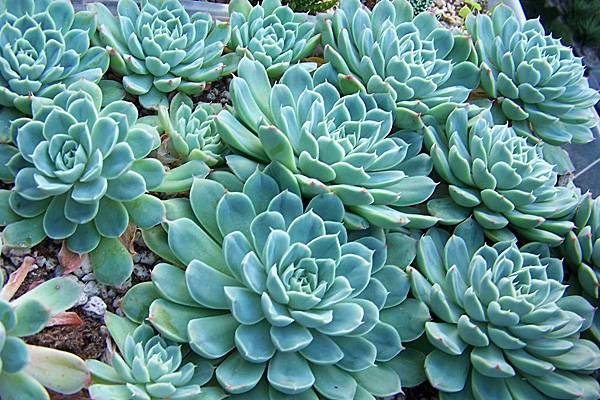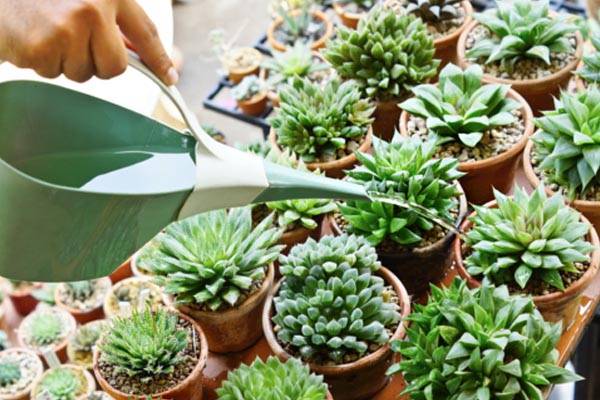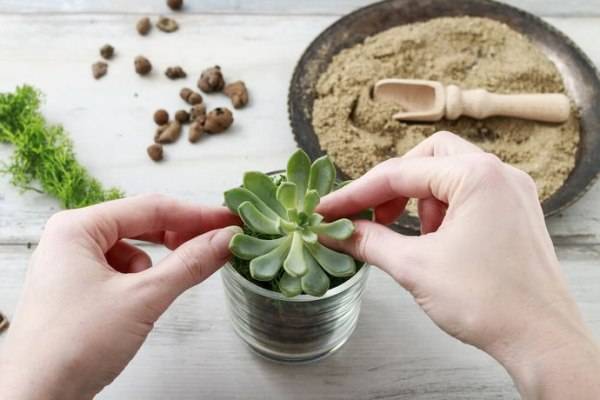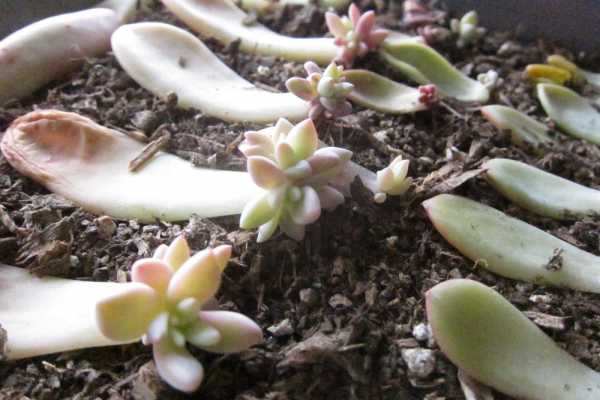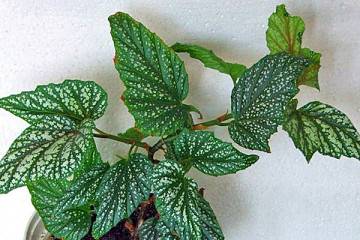Echeveria - care and reproduction at home
Content:
Echeveria flower belongs to heat-loving plants, grows well at home. Differs in unpretentious care, does not require special knowledge for cultivation. Therefore, it is difficult to pass by the stone rose, as it is also called, indifferently.
Echeveria - what is this flower
The succulent echeveria (echeveria) is a perennial of the Tolstyankov family. Under natural conditions, there are about 200 varieties, a small number are grown as ornamental varieties.
In nature, it is common in America - California, Peru and Mexico. The name of the species was given in honor of the Mexican artist describing the flora of the country - Atanasio Echeverría y Godoy.
At home, flower growers prefer Echeveria Shaviana, which is characterized by a corrugated crest and pinkish leaves along the edge. Echeveria humpback-flowered, desmet and agavoides also deserve no less attention.
The culture has bluish-bluish foliage, the largest subspecies reach 15 cm wide and 25 cm long. Stems are even, miniature. The foliage is collected in a tight outlet, resembles a rose in appearance. Some varieties have a smooth surface, others have pubescent.
Varieties of indoor plants
The species of the Echeveria flower are very diverse, there are from 150 to 200 varieties. They are engaged in growing crops not only in pots, but also in glass vases.
Echeveria graceful (Echeveria elegans)
Echeveria has graceful bluish-gray foliage, a flat rosette. Shoots are straight, eventually take a horizontal position and spread along the ground, are able to root themselves in the soil.
Large plants have rosettes up to 15 cm in diameter, babies develop on tall processes. The average width of the leaves is 2 cm, the length is 5 cm. The inflorescences have a pinkish or bright scarlet shade, with a yellow edging on top.
Echeveria carnicolor
According to the description, it has a short, branching stem, up to 6 cm in length.
The rosette is medium in size, up to 15 cm in height, up to 10 cm in width. The foliage is of medium density, the color resembles meat. It reaches 7 cm in length.
Echeveria glauca
It has a gray-blue foliage with a pinkish border along the edges, leaf plates with a gray waxy bloom, resembling a spoon in shape.
Inflorescences are located on lateral peduncles, flowers are orange in color.
Echeveria Black Prince
The succulent is distinguished by a fleshy rosette, up to 15 cm in diameter.Foliage casts light green, inflorescences are located in lateral pentamellas.
Flowers of Echeveria Black Prince with alo-chocolate or orange hue, are on a high stem.
Echeveria white-haired (Echeveria leucotricha)
It belongs to pubescent varieties, whitish hairs grow on green leaves with a brown border. Outwardly, the culture resembles a newborn animal, the diameter of the rosette is up to 20 cm.
Echeveria brilliant (Echeveria fulgens Lera)
Small and bushy, with thick shoots extending from the main outlet. Children grow on them. Foliage with a light green tint, covered with a waxy bloom at the edges.
The standard size of the leaves is 10 by 4 cm. It blooms in the cold of February with reddish flowers.
Echeveria Derenbergii
The difference between this variety is considered to be a lot of creeping shoots extending from the main outlet (6 cm in diameter).
The top of the foliage is decorated with a scarlet border, the general shade is bluish-olive or whitish. Spike-shaped inflorescences consist of five flowers, the length of the pedicel is up to 6 cm.
How to care for echeveria at home
Compliance with the rules allows you to get a beautiful and healthy crop that blooms according to the schedule, in accordance with the characteristics of the variety. Echeveria, the care of which is not difficult, nevertheless, has its own requirements for the soil, the frequency of moisture and feeding.
Illumination and temperature conditions
Conditions of detention depend on the season and additional factors:
- room temperature - in autumn and winter from 10 to 16 degrees, during flowering - from 18 to 21 degrees;
- in spring and summer - it feels good in dry air and temperatures up to 30 degrees.
All varieties adore the sun - the color and density of the foliage depends on the amount of light.
Watering rules and humidity
Water the succulent only after the soil in the pot has dried thoroughly. In winter, the frequency of soil moisture is reduced to a minimum - otherwise, excess water will lead to a tilt of the stem.
Before the procedure, tap water is defended for 48-72 hours or aquarium water is used - it will act as a kind of feeding.
Top dressing and soil quality
In the spring-summer period, they are fed with special mineral fertilizers for succulents and cacti, the procedures are carried out monthly. Starting in autumn and throughout the winter, feeding is not carried out, as well as after transplanting into a new land. Echeveria does not need organic and nitrogenous fertilizers.
She prefers low-nutrient, sandy and loose soil, with a neutral reaction. Ready-made store mix for succulents and cacti is most suitable for her. If you wish, you can make a soil mixture yourself, choose one of the options:
- mix 1 part of sod and leaf land, 2 parts of river sand;
- 1 part of loamy and peat soil and 2 parts of coarse sand.
To prevent the development of root rot, a small amount of charcoal is added to the soil mixture.
Flower container size
A shallow root system requires a wide pot with minimal depth. Its diameter should be 1.5-2 cm larger than the flower itself.
Do not take products without drainage holes - moisture stagnation and root decay will begin.
Pruning and replanting
Transplant operations are carried out annually. They act as carefully as possible, trying not to damage the root system and foliage.
After the purchase, the culture must be transplanted after a few weeks - until the appointed day, watering is completely stopped. The movement takes place with an absolutely dry earthen clod and only then the soil is moistened.
Special pruning is not carried out - the dried lower leaves are regularly removed in order to preserve the decorative appearance of the culture.
Features of flowering plants
Not all types and hybrids of succulents bloom, some of them require special conditions.
Echeveria blooms more often in the spring and summer months, lasting from 2 to 4 weeks.
Most varieties retire in winter. This time requires good lighting and temperature conditions from 8 to 15 degrees. Watering is reduced to once a month.
A long lateral or vertical peduncle emerges from the outlet; small flowers collected in inflorescences are located on it.
The color of the petals directly depends on the level of illumination. Insufficient light results in yellow flowers, and bright light results in orange or reddish flowers. After the end of flowering, children are formed on the peduncle.
Flower propagation methods and when it is best to do it
There are several methods to help propagate a culture. The most convenient methods for breeding echeveria include leaf and rosette.
Reproduction of echeveria by a leaf
A leaf is separated from the mother's body, dried within a week. This principle helps to avoid its rotting in the ground. The outer side of the leaf plate is laid on moistened soil and rooting is expected at a temperature of 25 degrees. After the appearance of the first outlet, the culture is seated in separate boxes.
Reproduction by rosettes
It belongs to the popular methods, it is carried out by separating the daughter from the mother.
The cut is treated with charcoal powder and dried for 12 hours. After that, the rosette is planted in wet sand and await rooting. The method allows you to get a quick appearance of peduncles
Growing problems, diseases and pests
Succulent varieties are rarely attacked by insects and diseases, in most cases, problems arise if they are not properly cared for. Frequent and excessive moisture provokes the development of powdery mildew and root rot. To prevent their appearance, it is necessary to carry out rare moistening of the soil - only after it dries to a depth of several centimeters.
Mealy and root bugs are especially dangerous for succulents. They cause an arrest of growth and development, are determined by whitish bloom and deformation of the flower. Treatment - transfer to a new container with the simultaneous removal of damaged areas. At the end of the procedure, the treatment is carried out with a solution of Fitoverm and Aktar.
How to deal with them
Treatment depends on the type of problem:
- yellowing of foliage - caused by stagnation of water in the ground, it is recommended to stop moistening Echeveria until the earthy coma dries;
- lethargic and wrinkled leaves occur when there is a lack of fluid;
- drying out of the lower ones is a normal phenomenon in winter, after falling off, the formation of children begins.
If the leaves of the culture dropped and some of them began to fall off, then the problem is associated with excessive moisture in the winter. If you follow all the care recommendations, then the main difficulties will not arise.
Echeveria is an original and beautiful flower that is very popular with gardeners. They use it to decorate greenhouses, alpine slides in their backyards and living quarters in houses. Home care for satin, bristly or black prince echeveria is not difficult even for inexperienced gardeners.
